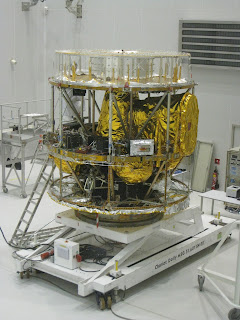Unpacking the 20 containers has been swiftly and quite efficiently managed by Thales.
After MSG-3 was mounted on a multipurpose Dolly Carriage (Chariot Dolly) last Saturday, it was towed from the transit hall to the clean room as shown below.
A thorough inspection of the Spacecraft interior is now foreseen shorty. Therefore it was necessary to undress MSG-3 from its 8 solar arrays that are covering the external side of the cylinder.
Below, one can see the "naked" spacecraft on the right hand side and the dismounted solar arrays hanging on the left hand side with their protective Plexiglas covers. Solar arrays are indeed extremely fragile items.
The two pictures below were taken from the window of the visitor room on the 1st floor of the S5C building. This location may sometimes be quite convenient to follow activities without entering the clean room and/or disturbing on-going work. When activities are confidential, a blind can be pulled to cover the window.
On the close up picture below, one can see MSG-3 primary structure.
In the Center of the Spacecraft, the biggest element filling this rather empty volume is the SEVIRI telescope. The SEVIRI is the payload imager that is designed to provide Earth pictures. We shall come back on that later. On the lower part of the spacecraft, one can see the propellant tanks all covered with the yellowish insulation foil called MLI (Multi Layer Insulation)...
For motivated readers willing to know a bit more on the satellite description, the following picture gives a rough idea of the MSG Spacecraft design. By comparing both pictures, few other subsystems can be recognised.
Credits EUMETSAT/ESA
For the best ones, have you noticed which visible element is obviously still missing?



No comments:
Post a Comment
Note: Only a member of this blog may post a comment.